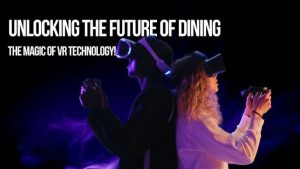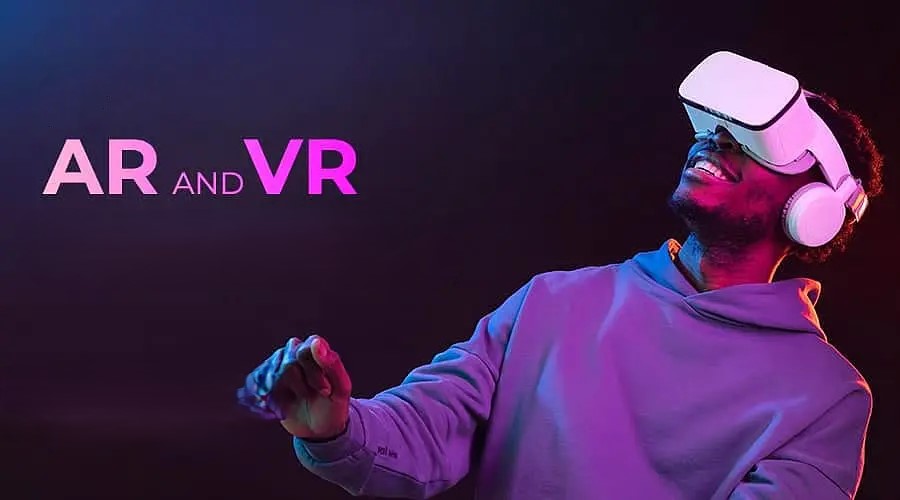Introduction
In 2025, dining is being changed by new technologies. Augmented Reality (AR) and Virtual Reality (VR) are no longer just for gaming they’re now transforming how we experience food in restaurants. Imagine sitting at a dinner table where your food is surrounded by interactive visuals, or where you eat in a different world, part of an adventure. This is the future of dining, where AR and VR make eating out more exciting, fun, and unforgettable.
But how exactly are these technologies changing the dining experience? Let’s take a look at how AR and VR are being used in restaurants and what this means for food lovers.
What is Immersive Dining with AR and VR?

Immersive dining is a new concept that combines traditional dining with high-tech features. AR and VR add interactive elements to your meal.
AR (Augmented Reality) adds digital features to the real world. By using a phone or special glasses, diners can see extra information, like animations or virtual guides that explain the ingredients or history of a dish.
VR (Virtual Reality) fully transports the diner into a digital environment. With a headset, diners can enter a virtual world while they eat, creating a truly unique experience. For example, you could eat Italian food in a virtual ancient Roman setting.
Both AR and VR let restaurants offer more than just food they create an experience that is fun, educational, and memorable.
Role of Immersive Dining: Innovating Hospitality and Entertainment
Immersive dining plays a pivotal role in innovating the hospitality industry by leveraging AR and VR technologies. Restaurants can now offer virtual tours of exotic locations, interactive storytelling, and themed environments that transcend the typical dining experience. This innovation not only enhances the dining ambiance but also provides entertainment value, appealing especially to tech-savvy consumers who value experiential dining and seek memorable outings. It creates a dynamic fusion of food, technology, and entertainment, setting new standards for customer engagement and satisfaction in the dining sector.
How AR and VR Are Changing the Dining Experience

1. Enhancing the Menu Experience
One exciting way AR is used in restaurants is by making the menu more engaging. Instead of just reading descriptions, you can point your phone at a menu item and see a 3D image of the dish. You might even watch a virtual chef explain how it’s made. This makes the food feel more real and interactive.
Some restaurants also use AR to show the ingredients in a dish when you hover your phone or tablet over it. This helps diners understand what’s in their food and make healthier choices.
2. Interactive Dining and Entertainment
VR takes immersive dining to the next level. Some restaurants create virtual worlds where diners can eat in settings that match their meal. For example, you could enjoy sushi while being virtually transported to a beach in Japan or have a medieval feast in a virtual castle.
This makes dining more fun and adds entertainment, especially for special occasions. The mix of VR and food turns your meal into an adventure.
3. Personalizing the Dining Experience
AR and VR can also personalize your dining. For example, some restaurants let diners create virtual avatars that interact with the menu. Your avatar might suggest wine pairings based on your preferences, or explain your dietary needs. This personal touch makes the meal feel even more special.
For restaurants, this creates opportunities for unique dining experiences where each meal is more than just food—it’s a complete virtual experience.
4. Virtual Food Pairings and Cooking Classes
VR is also being used for virtual cooking classes and food pairings. Diners can join in immersive lessons where they learn how to prepare dishes or pair wines. Picture a virtual cooking class where an instructor guides you step-by-step, while you enjoy the meal in a virtual space.
This turns dining into an active experience, helping diners connect with food and culture in a deeper way.
Benefits of AR and VR in Dining

1. Increased Customer Engagement
By offering something unique, AR and VR make dining more engaging. Customers don’t just eat—they get to explore new worlds and learn about their food in an exciting way.
2. Differentiation and Competitive Advantage
For restaurants, using AR and VR can help them stand out. In a crowded industry, offering immersive dining experiences can encourage repeat visits and attract new customers.
3. Enhanced Branding and Storytelling
AR and VR allow restaurants to tell their stories in new ways. They can show the origins of ingredients, explore the history of a cuisine, or take diners on a virtual journey through food preparation. These technologies help restaurants connect with customers more deeply.
4. Sustainability and Waste Reduction
Some restaurants use AR to show the environmental impact of food choices. A diner might scan a dish and learn about how sustainable the ingredients are. VR can also simulate the journey of food from farm to table, helping diners understand where their meal comes from.
Challenges of Immersive Dining: Technical Integration and Customer Adoption
Despite its advantages, immersive dining faces challenges in seamlessly integrating AR/VR technologies into existing dining environments. Technical hurdles include ensuring the reliable operation of technology, maintaining sustained customer interest beyond initial novelty, and balancing virtual enhancements with the authenticity of the dining experience. Overcoming these challenges requires ongoing technological advancements, strategic implementation, and effective customer education to foster widespread adoption and acceptance. Additionally, restaurants must navigate the costs and logistics of implementing and maintaining immersive dining experiences while ensuring they enhance rather than distract from the dining experience.
The Future of Immersive Dining

The future of immersive dining looks promising, with AR and VR continuing to transform the way we eat out. As the technology improves, dining experiences will become even more immersive and interactive. We may see more restaurants using AR to create virtual food displays or VR to transport diners to different worlds while they eat. In the future, immersive dining could become a standard feature in many high-end and casual dining establishments, offering customers new ways to experience food and entertainment at the same time.
Comparative Table: Comparison of AR and VR in Dining
| Technology | Key Features | Benefits | Ideal For |
|---|---|---|---|
| Augmented Reality (AR) | Adds digital elements to the real world, interactive menus | Enhances the menu, provides visual context for dishes | Restaurants with diverse menus, educational dining |
| Virtual Reality (VR) | Fully immersive environments, virtual cooking classes | Transports diners to themed environments, offers entertainment | Special events, immersive food classes |
Conclusion
Immersive dining is an exciting frontier where AR and VR are transforming the dining experience. By enhancing menus, providing entertainment, personalizing experiences, and offering virtual cooking classes, these technologies are taking dining to the next level. For restaurants, adopting AR and VR can lead to higher engagement, a stronger brand, and unique experiences for customers.
As we move forward, AR and VR will continue to shape the dining world, offering unforgettable experiences for food lovers and setting new standards for the future of dining.
Call to Action
Ready to try immersive dining? Find restaurants that use AR and VR to transform your dining experience. Explore a world where food, technology, and adventure come together for an unforgettable meal. Visit a tech-savvy restaurant today and discover the future of dining!




